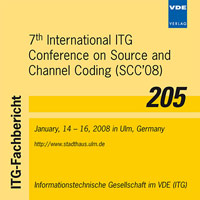Training Sequence Design for EDGE System with Dual Symbol Rate
Conference: SCC'08 - 7th International ITG Conference on Source and Channel Coding
01/14/2008 - 01/16/2008 at Ulm, Germany
Proceedings: SCC'08
Pages: 6Language: englishTyp: PDF
Personal VDE Members are entitled to a 10% discount on this title
Authors:
Hao, Dapeng; Badri-Hoeher, Sabah; Hoeher, Peter Adam (Information and Coding Theory Lab, Faculty of Engineering, University of Kiel, Germany)
Abstract:
The Dual Symbol Rate (DSR) technique is a candidate for GERAN (GSM/EDGE Radio Access Network) evolution and has recently gained much interest. DSR uses the concept of decreasing the symbol duration to increase the uplink data rate of EGPRS (Enhanced General Packet Radio Service). The conventional GSM/EDGE training sequences can not be adopted to the EDGE system enhanced by DSR since the channel memory is doubled. New training sequences have to be designed for channel estimation. In this paper, eight training sequences with perfect auto-correlation properties and minimized cross-correlation properties have been designed. Their mean square cross-correlation function is three time smaller than that of the GSM training sequences, thus improving the system performance in the presence of co-channel interference or when using multiple transmit antennas. In addition, the performance of suboptimum equalizers is also investigated for the EDGE systems with DSR. It is shown by simulation that the system performs well in ‘Typical Urban’ areas without increasing the computational complexity significantly.


